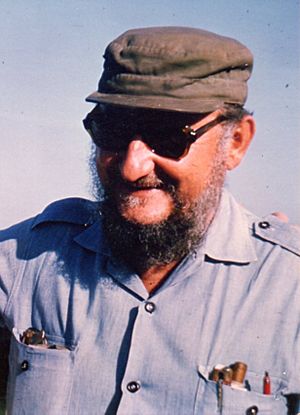Ramón Castro Ruz facts for kids
Quick facts for kids
Ramón Castro Ruz
|
|
|---|---|
 |
|
| Born |
Ramón Eusebio Castro Ruz
14 October 1924 Birán, Cuba
|
| Died | 23 February 2016 (aged 91) Havana, Cuba
|
| Spouse(s) | Janice Castro |
| Children | 3 |
| Parent(s) | Ángel Castro y Argiz (father) Lina Ruz (mother) |
| Relatives | Fidel Castro (brother) Raúl Castro (half brother) Juanita Castro (sister) |
Ramón Eusebio Castro Ruz (born October 14, 1924 – died February 23, 2016) was an important person in Cuba. He was the oldest brother of Fidel and Raúl Castro. Ramón played a key role in the Cuban Revolution, even though he wasn't a soldier.
Contents
About Ramón Castro
Early Life and Family
Ramón was the oldest of the Castro brothers. His father, Ángel Castro, was a rancher from Spain. His mother was Lina Ruz. Ramón grew up on his family's large farm in Birán, located in eastern Cuba.
He studied agricultural engineering. This means he learned about farming and how to grow crops and raise animals. He spent his life working with plants and livestock.
Ramón's Look and Nickname
Ramón looked a lot like his brother Fidel. An American journalist named Sally Quinn met him in 1977. She described him as a big, strong man with a beard and a friendly smile.
People in Havana often thought Ramón was Fidel when they saw him. Ramón would tell them, "No, I'm Mongo." Mongo was a special nickname only his family and close friends used.
His Role in the Cuban Revolution
Ramón Castro did not fight in the armed rebellion like his brothers. However, he helped the revolution in other important ways. He was like a quartermaster for Fidel and Raúl's troops. This means he made sure they got weapons and supplies.
He also set up ways to get supplies from cities to the soldiers in the countryside. During a time when gasoline was hard to find, he even made a special fuel from alcohol for Cuba. He once said he led a group of 1,200 men who helped get things for the war.
After the Revolution
After the revolution, the family farm became government property. It was a very large farm, about 87.6 square kilometers (33.8 square miles). It grew sugar cane and oranges, and raised cattle. Ramón was allowed to keep a smaller part of the farm, about 4 square kilometers (1.5 square miles).
Sometimes, Ramón disagreed with the new government. For example, in 1959, he defended a newspaper that the government didn't like. He was also criticized for his role in a sugar cane growers' group.
His Work and Legacy
Ramón worked as an advisor for government groups. He started state-owned companies that managed orange production and sugar cane transport. He was one of the people who helped create the Communist Party of Cuba in 1965. He also served in the National Assembly of People's Power, which is Cuba's main law-making body.
He worked to improve farming methods for sugar cane and dairy cows. In the 1990s, he helped bring cattle from Florida to Cuba. This led to a new type of cattle being created.
Ramón once said that his brother Fidel was focused on politics. But Ramón preferred to be free and work with people on the ground. Unlike Fidel, Ramón continued to smoke cigars until he passed away.
In 2007, when Fidel was recovering from surgery, Ramón said that his brother was doing very well. He added that all the Castro brothers were very strong and resilient.
Family and Death
Ramón and his wife, Janice, had three children: Ramón Omar, Lina, and Ángel Castro.
Ramón Castro died on February 23, 2016. His death was announced in Granma, which is the official newspaper of the Cuban Communist Party. His brother Fidel died about nine months later, on November 25, 2016.
See also
 In Spanish: Ramón Castro Ruz para niños
In Spanish: Ramón Castro Ruz para niños

